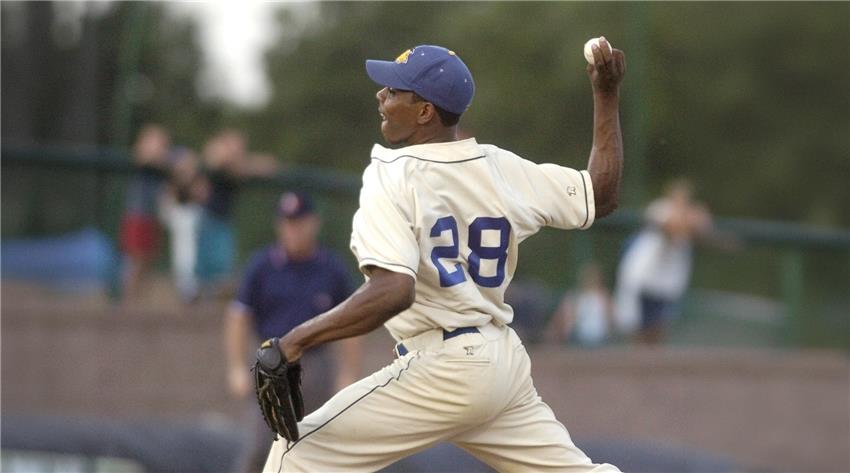
From the Mound to the NFL Draft - Why Baseball Pitchers Make Elite Quarterbacks
Finding the next great NFL quarterback is the ultimate quest for scouts and coaches alike. But what if the key to unlocking exceptional arm talent and throwing prowess lies not just on the football field, but on the baseball diamond?
That's right—some of the best quarterbacks in NFL history, including stars like Russell Wilson and Patrick Mahomes, honed their skills as baseball pitchers before taking their talents to the gridiron.
Think about it: the precision, the power, the mechanics—it's all there in baseball pitching. The kinetic chain used in throwing a baseball translates remarkably well to throwing a football, enhancing a quarterback's ability to deliver accurate and powerful passes. The results speak for themselves. Russell Wilson, drafted by the Colorado Rockies, and Patrick Mahomes, selected by the Detroit Tigers, have both turned their dual-sport backgrounds into NFL success stories.
In this article, we'll dive deep into how the unique skill set developed through baseball pitching can make a significant difference in a quarterback's performance. We'll explore the mechanics, the mental toughness, and the case studies of successful QB/pitchers to make the case for why scouts should keep an eye on the baseball field when searching for the next football phenom.
The Unique Arm Talent from Baseball
When it comes to arm talent, the mechanics of throwing a baseball and a football aren't as different as you might think. In fact, the skills honed on the pitcher's mound can translate exceptionally well to the football field, giving quarterbacks a significant edge in both power and precision.
Throwing Mechanics
Baseball pitchers spend countless hours perfecting their throwing motion, focusing on every minute detail to maximize their performance. This dedication to mechanics pays dividends when they switch to throwing a football. The kinetic chain—the sequence of movements that starts from the legs and moves up through the torso, shoulder, arm, and finally the hand—is remarkably similar in both sports.
Consider Russell Wilson. Drafted by the Rockies, Wilson's background as a pitcher has endowed him with a fluid, repeatable throwing motion that enhances both his accuracy and velocity. According to sports performance coach Tom House, who has worked with both MLB pitchers and NFL quarterbacks, the rotational movements and weight transfer involved in pitching are nearly identical to those in a football throw. This means that a quarterback with pitching experience can often make more precise and powerful throws, a key advantage in the high-stakes world of professional football.
Arm Strength and Endurance
Pitching isn't just about technique; it also builds significant arm strength and endurance. The repetitive nature of pitching, combined with the need to throw at high velocities, helps develop the muscles required for powerful football throws. Patrick Mahomes, known for his cannon-like arm, spent his formative years as a high school pitcher, where he developed the arm strength that now sets him apart in the NFL.
Mahomes' ability to launch deep passes with ease is a testament to the conditioning and muscle memory built during his baseball career. His seamless transition from baseball to football demonstrates how pitchers can bring a unique arm talent to the quarterback position, allowing them to make throws that others can only dream of.
Case Studies of Successful QB/Pitchers
Let's take a closer look at some of the most successful quarterbacks who started as pitchers:Russell Wilson
Wilson's journey from the baseball diamond to the football field is a textbook example of how pitching skills can translate to quarterback success. His tenure with the Rockies' minor league system helped him refine a throwing motion that's both efficient and powerful. On the football field, Wilson's ability to make precise throws while on the run has been a game-changer for the Seahawks and now the Broncos.
Patrick Mahomes
Mahomes, another standout example, showcases the benefits of a baseball background every time he steps on the field. His unique throwing angles and ability to make off-platform throws are directly tied to the diverse throwing situations he faced as a pitcher. The Kansas City Chiefs star quarterback consistently amazes fans and analysts with throws that defy conventional football mechanics, a clear legacy of his baseball training.
John Elway
Before he was an NFL legend, Elway was a standout pitcher, drafted by the Yankees. His time on the mound taught him the importance of precision and control, skills that translated into a Hall of Fame football career. Elway's powerful arm and ability to read defenses were enhanced by his baseball experience, proving that the discipline and mechanics of pitching can create an exceptional quarterback.
These case studies underscore a critical point: the mechanics and skills developed as a baseball pitcher provide a strong foundation for success as an NFL quarterback. The precision, power, and control required in pitching can give quarterbacks a significant edge, making the case for scouts to broaden their search to the baseball diamond when looking for the next great NFL QB.
The Science Behind the Throw
When you break down the mechanics of a baseball pitch and a football throw, the similarities are striking. The biomechanics involved in both motions rely heavily on the body's ability to generate rotational power, maintain balance, and execute precise timing. This section dives into the science of throwing and how it equips pitchers with skills that translate seamlessly to the quarterback position.Biomechanics of Throwing
The act of pitching a baseball and throwing a football involves a complex sequence of movements that start from the lower body and transfer energy through the core to the throwing arm. This kinetic chain ensures maximum velocity and accuracy, which is essential for both sports.
Tom House, a renowned throwing coach who has worked with top athletes in both baseball and football, often emphasizes that the kinetic sequence for an efficient throw is almost identical between the two sports. For example, the weight transfer from the back leg to the front, the hip rotation, and the follow-through all mirror each other, which means that the muscle memory developed in pitching can be directly applied to football.
Rotational Power and Accuracy
Rotational power is crucial for both pitchers and quarterbacks. It allows for the generation of high velocity while maintaining control and accuracy. In baseball, pitchers need to throw fastballs exceeding 90 mph with pinpoint precision, which involves a finely tuned coordination of muscle groups from the legs through the torso and into the arm. This same rotational power is what quarterbacks like Patrick Mahomes utilize to launch deep passes accurately downfield.
Studies have shown that the torque generated in a baseball pitch can enhance the overall arm strength and control needed for effective football throwing. Mahomes' ability to make incredible throws from various angles and body positions is a direct result of the rotational mechanics he mastered as a baseball pitcher.
Enhanced Arm Durability
One often overlooked benefit of a baseball background is the development of arm durability. Pitchers are trained to handle the intense demands of throwing repeatedly at high speeds without compromising arm health. This conditioning can be beneficial for quarterbacks, who also need to throw frequently and with considerable force.
By incorporating pitching mechanics, quarterbacks can reduce the risk of arm injuries. The repetitive, controlled motions of pitching foster a resilience in the arm's muscles and tendons, which can be advantageous during the grueling NFL season.
Benefits Of Football-Only Backgrounds
Quarterbacks with a baseball background bring a unique versatility to their throwing game. The diverse range of throws required in baseball—from fastballs to curveballs—teaches adaptability that is invaluable on the football field. This ability to adjust and throw accurately from different angles and under various pressures is something that sets players like Russell Wilson and Patrick Mahomes apart from their peers.
Wilson’s skill at making throws on the run, or Mahomes’ knack for completing passes while off-balance, are directly linked to their baseball experience. These skills are not as commonly developed in quarterbacks who have only focused on football throughout their careers.
Mental Toughness and Game Management
Pitching in baseball requires a high level of mental toughness and strategic thinking. Pitchers must analyze hitters, anticipate their reactions, and maintain composure in high-pressure situations. This mental aspect of baseball pitching translates well to the role of a quarterback, who must read defenses, make quick decisions, and stay calm under pressure.
For example, John Elway's strategic approach to the game and his ability to perform in clutch moments can be traced back to his experience as a pitcher. The pressure of standing on the mound in a critical baseball game mirrors the intensity of leading a team downfield in the final minutes of a football game.
Looking Forward
The evidence is compelling: the skills honed as a baseball pitcher can provide a serious upside for NFL quarterbacks. The precise mechanics, arm strength, rotational power, and mental toughness gained from pitching translate seamlessly to the demands of pro football. As the quest for the next great NFL quarterback continues, scouts and coaches need to broaden their horizons to include the baseball diamond. The next Patrick Mahomes or Russell Wilson might just be perfecting their fastball as we speak.
A number of current college quarterbacks eligible for the 2025 NFL Draft have this very baseball background. Shedeur Sanders at Colorado, with his twitchy arm and impressive accuracy, has benefited from his time on the baseball diamond. Drew Allar from Penn State showcases the powerful deep-ball and precision that comes from pitching. Cameron Ward, now at Miami, has the elite arm talent and a creative playstyle honed by his baseball experience. Jalen Milroe at Alabama combines a strong build with arm strength, both refined by his baseball past. Conner Weigman of Texas A&M, with his dual-sport background, displays both arm talent and accuracy, making him an under-the-radar prospect with the ability to make a splash at the next level..
These quarterbacks not only bring football talent, but also the unique advantages of their baseball experience. NFL teams looking to find the next standout quarterback should consider these dual-sport athletes for their blend of skills, mental toughness, and versatile throwing abilities. As the 2025 NFL Draft approaches, keeping an eye on these guys might be the key to discovering the next superstar quarterback.
